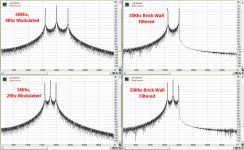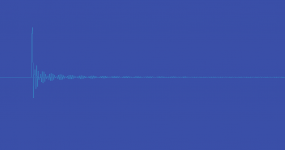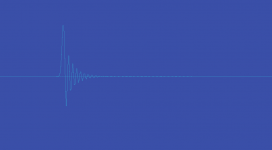If the sweep is a slow change, no. But let's forget FM for now.So one should be able to do a test using Fs=1ksps and sweeping a tone and as it is nearing the corresponding Fs, one should hear, or maybe measure with a microphone, a frequency shift?
I have no idea if this is so - must admit that intuitively for me it should not happen - but if it does, I'm happy that it is out of my hearing range 🙂
//
There is no shift for a single sine being filtered. It is only when an envelope generated sideband is filtered out that anything can change.
jn
No sidebands for a sine.Aha... but there isn't any sideband for a sinus - right? Why are anything modulated with sidebands? Other distorsion within the system prior to filtering?
//
When a sine is amplitude modulated, yes. Think percussive instrument, where the sine amplitude changes very fast.
jn
ps..Scott,
I make the assumption that the person you spoke of has the ability to derive this stuff in his head. Pass it by him. If he concurs, I hope he puts a paper together and publishes. That would be so neat..
Last edited:
That crossed my mind, momentarily too. 🙂 Shame, there doesn't seem to be any way to test it like this?If the sweep is a slow change, no. But let's forget FM for now.
A perfectly A/D converted music signal of the last 10 seconds of Mahlers 2nd doesnt have any modulated content except for what happened in the hall, which, to the perfect reproduction chain, doesn't contain any modulation at all - just discrete unmodulated tones.
No?
//
No?
//
That crossed my mind, momentarily too. 🙂 Shame, there doesn't seem to be any way to test it like this?
Sure. Vary the sweep speed.
Very slow, no Gibbs envelope until Fs exceeded.
Very fast, Gibbs when the sideband hits Fs.
Scott's difference method is very strong..
jn
A brickwall filter at 20k of a signal that's sampled at 192k as in Hans examples, in what way?Many of the alternatives end up violating Nyquist which would be a confounder for interpretation.
ps..Scott,
I make the assumption that the person you spoke of has the ability to derive this stuff in his head. Pass it by him. If he concurs, I hope he puts a paper together and publishes. That would be so neat..
Better to ask Ed he knows who it is. He agreed in principle on using the Hilbert transform to compute the envelope, but cautioned that there is a lot of work involving perceptual issues to determine the audibility. I think we are still at the point where I would get a WTF answer.
I will also repeat the modeling an ideal quantizer mathematically gives images and aliases. The 20 by 4 should have the 24 component removed before sampling at 44.1.
Because I don't like being accused of doing something wrong, I took a deep breath and plotted 20/4 and 18/2 together in one image.I must admit, I am quite shocked you provide input and output waveforms that are absolutely different, but yet you say nothing has changed..😕
I provided the mathematical basis..
jn
Are they the same ?
No they are not.
Hans

A brickwall filter at 20k of a signal that's sampled at 192k as in Hans examples, in what way?
Many are not brickwall at all, no ringing no Nyquist. Think Wadia and their French curve. I can't speak to what Hans is using for a brickwall filter but there is attenuation at 20k and the floor beyond is not that low. My plots were exactly flat to cutoff and -300dB beyond.
Last edited:
But that's not what I said to do. Do it in the time domain. Was that error intentional, or did you not understand what I said to do?Because I don't like being accused of doing something wrong, I took a deep breath and plotted 20/4 and 18/2 together in one image.
Are they the same ?
No they are not.
Hans
View attachment 818660
I said your sentence was a mischaracterization of what I said, and I also said that I think you did not intend that.
Oddly enough, nobody is asking the right questions.
1. Why is Jn mentioning one lobe vs two.
2. Why is Han's' FFT of a 20/4 showing the carrier when it's suppressed carrier modulation?
The answer to #2 is buried in question 1.
Jn
Better to ask Ed he knows who it is.
I already know who it is.
Jn
2. Why is Han's' FFT of a 20/4 showing the carrier when it's suppressed carrier modulation?
Come on now picking the amplitudes to suppress the carrier is just numbers.
Scott, I didn't mean no ringing, I ment no pre-ringing. I was wondering how the waveform in time domain will look with different filter and what "frequency shift" will show up. Also, I don't think the "not that low" noise floor beyond 20k is important when looking at waveform where Gibbs artifacts are of similar scale as main signal.Many are not brickwall at all, no ringing no Nyquist. Think Wadia and their French curve. I can't speak to what Hans is using for a brickwall filter but there is attenuation at 20k and the floor beyond is not that low. My plots were exactly flat to cutoff and -300dB beyond.
Below are screenshots of response to a single impulse of two filters at 20k (fs=96k) that I have at hand and am willing to try out on any provided test signal. Those are the steepest that I have - one has 102dB/oct slope, the other has 80db stopband attenuation.
Attachments
Last edited:
HansI took a deep breath and plotted 20/4 and 18/2 together in one image.
View attachment 818660
The upper right is 20kHz, 4kHz modulated brick wall filtered
The lower right is it 18kHz, 2kHz modulated brick wall filtered?
George
Here's the final chapter of Vicki Melchior's recent AES paper on high resolution audio. IMO, quite relevant to what we discuss here.
For those who want to read the whole paper, it is available here:
[PDF] High-Resolution Audio: A History and Perspective | Semantic Scholar
For those who want to read the whole paper, it is available here:
[PDF] High-Resolution Audio: A History and Perspective | Semantic Scholar
Attachments
From the days when i took entry level grad school sampling frequency i came up with a more graphic description. It is like a big Monty Python foot coming down out of the sky and squashing the music with stuff splattering everywhere.
dave
This is pretty much how a cymbal crash sounds compared to real life cymbal sounds. My choice of that was no accident. It is one of the big differences you (I) noticed with CD vs analog tape master recording of the cymbal.
The analog tape has no brick-wall filter and a gradual roll off above 20Khz or higher.
I also questioned whether there were enough sample points to reconstruct an accurate transient of non-continuous signal basis. 24/96 or more is needed.
And, so what BW would prevent issues JN shows? Well not prevent but be above 20KHz. What would make it inaudible on cymbals? 40KHz?
THx-RNMarsh
Last edited:
The analog tape has no brick-wall filter and a gradual roll off above 20Khz or higher.
I was taking that sampling course at the same time as we got the dealer Sony paper on the upcoming CD player technology. I read it thru and said they are going to have to up the sampling frequency by at least 4 before it starts to deal with some of the sutllties as well as analog. I’m amazed CD has gotten as enjoyable as it has.
dave
John, it this how you get people to cooperate with you in your work place? Just asking.
You ask a reasonable question, never a problem and I will answer you honestly.
I work with the most advanced people on the planet in their specialties. I made a superconducting magnet one day using the technology I personally developed. I had a heck of a time getting it to work for (IP content)... After test, the physicist asked me what I did to make it so bad. Given the issues with the process and why, I detailed why I thought the results were as they came out. He (the world leader in this field) told me that it was not possible, it doesn't work that way. I explained a bit more, he said he would think about it.
A week later he showed me a derivation that was 51 pages of analytical equations, starting with maxwells equations of course. I understood about a third of the way down the first page, then all I could do was drool. But he explained that my thinking was correct. I then detailed how I believe we could modulate the pattern to produce (more IP stuff) to produce even better, and that derivation was 28 pages, I again thought correctly. Our group is the world leader in this technology, and has been for 23 years now.
Over the years, our collaboration, including mech techs, mech engineers, scientists, have produced world leading devices. I am a part of a group, and within that group, all are listened to. Our own little skunkworks so to speak.
The point is not that I was correct, merely that I was listened to without casual dismissal. I apply that to all I work with, and very good things come out.
At no time was I ever dismissed at work because I was a mere coil winder (which is actually my third specialty here). At no time was I ever dismissed because I did not have a specific name for something. At no time was I given an explanation that was a diversion from the discussion.
And never was I dismissed because I was at a lower station than those I spoke to.
I post here specifically because there are those here who are above me in specific technologies, certain disciplines, certain science. I expect (because my work enviro is such) that what I bring to the table is not casually dismissed..and feel disappointment when some do so, some who I look up to.
Sorry for the run on. That said, my expectations of all here, are high. I continue to wish and hope that it is possible to collaborate on forum in the fashion I enjoy at work, but have to admit it does not look promising.
Jn
Last edited:
- Home
- Member Areas
- The Lounge
- The Black Hole......


